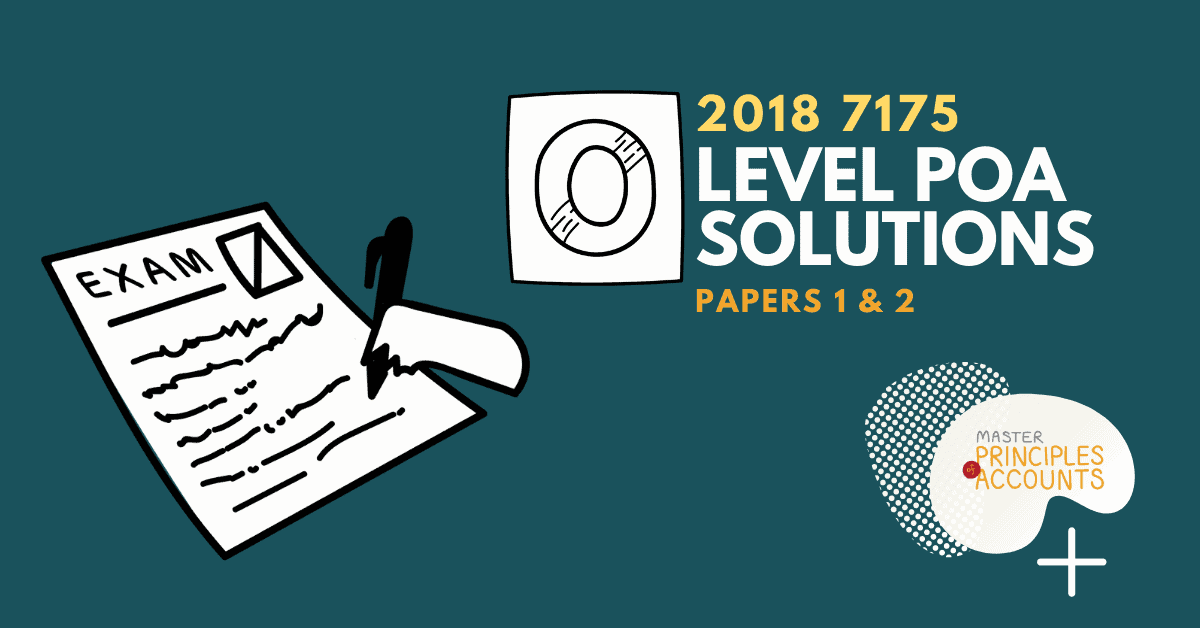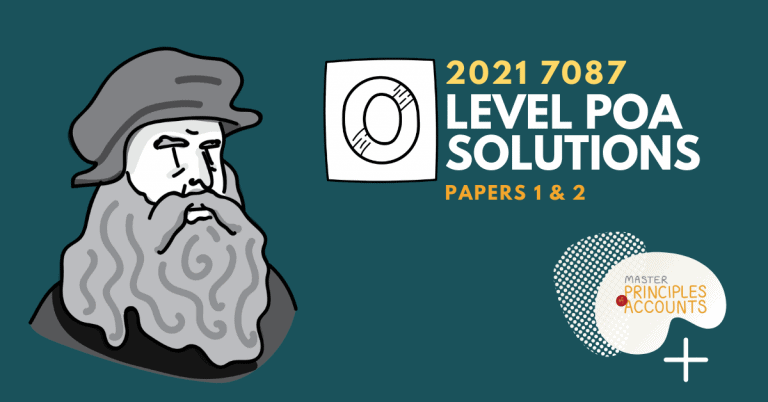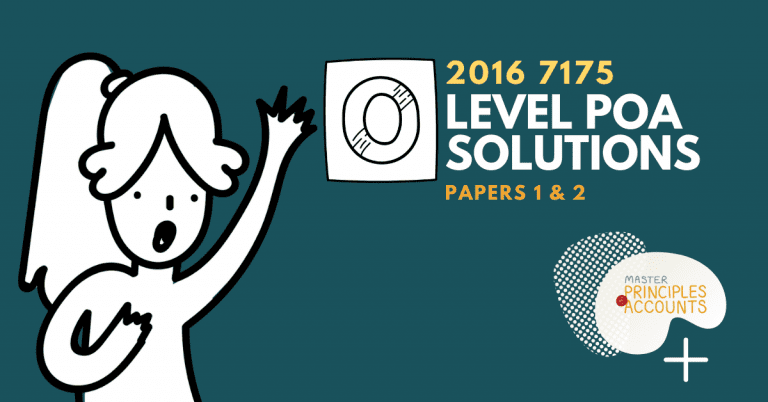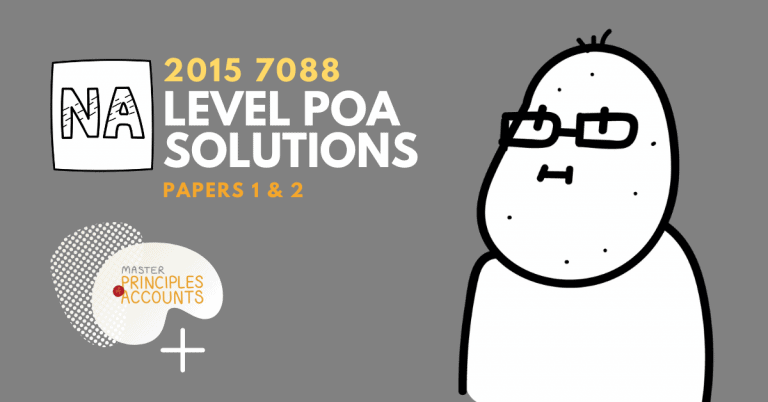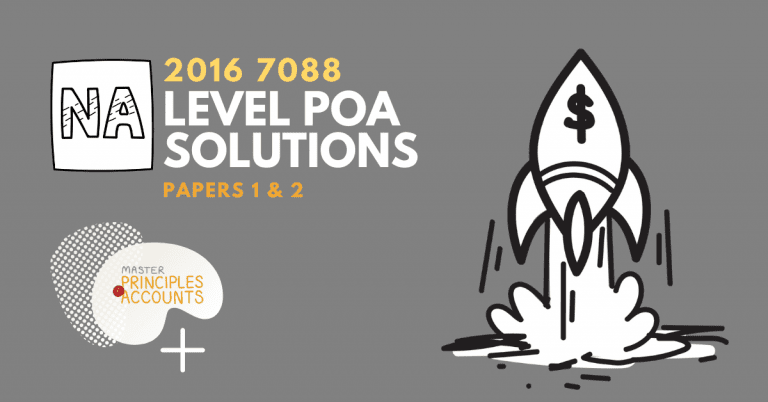2018 O Level POA Answers
Paper 1 :
(a) Materiality concept. Expenditures that should be capitalised as the cost of the non
current assets can be treated as expenses if the value of the item is insignificant (immaterial)
(b) General Journal
(c) Owner purchased equipment from overseas and needs to train staff to operate it. Identify
if the following costs is capital or revenue expenditure:
| Capital expenditure | Revenue expenditure | |
| Installation costs | ✔ | |
| Staff training | ✔ | |
| Import duties | ✔ |
(d)
Statement to show corrected profit for year ended 31 August 2018
| $ | $ | |
| Profit before adjustment | 240000 | |
| i) Less: repairs for existing warehouse* | (5,000) | |
| ii) Add: Legal fees related to gaining building permission | 1,250 | |
| Adjusted profit | 236,250 |
(e)
1. Decision-making.
2. Stewardship
(a) Total sales = Cash sales credit sales
Cash sales = $4,800 + ($1,000 X 12 months)= $16,800
Credit sales = $27,000 + $87,800 $22,000 = $92,800
Total sales = $16,800 + $92,800 = $109,600
(b)
(i) If gross profit margin = 40%
and Net sales revenue cost of sales = Gross profit,
NSR COS = GP
100% 60% = 40%
Cost of sales = $109,600 x 60% =$65,760
Expected inventory at 30 June 2018 = ($4,300 + $67,100 $980) $65,760 = $4,660
(ii) Value of inventory destroyed = Expected inventory actual inventory = $4,660 $2600
(c) Going concern concept
(a) Examples of income of SERVICE business
Any one of the following:
-Advertising income
-Consultancy income
-Tuition fee income
-Hair salon services
(ii) Examples of expenses of a SERVICE business
Any two of the following:
-Rent expense
-Advertising expense
-Wages expense
-Depreciation expense
(b)
Formula for expense to(Expenses/Net Sales Revenue) X 100%
| 2016 | 2017 | 2018 | |
| Workings | Expenses= $582,000 $361,000= $221,000 % expenses to NSR$(221,000/582,000) x100%= 37.97% | Expenses= $685,000 $452,000$233,000 % expenses to NSR=$(233,000/685,000) x100%34.01% | Expenses$655,000 $413,00$242,000 % expenses to NSR$(242,000/655,000) x100%: 36.94% |
| Expenses to net sales revenue % | 37.97% | 34.01% | 36.94% |
(c)
-Changes in profitability over 3 years (+ evidence from question)**
Sales revenue has increased steadily from $582,000 in 2016 to $685,000 in 2017 to $655,000 in 2018.
-In absolute terms, the business’ profits have fluctuated from 2016 to 2018. Business profits has increased from $361,000 in 2016 to $452,000 in 2017 and decreased to $413,000 in 2018.
-Although the number of bus tours has decreased from 650 in 2016 to 600 in 2017, the profit has increased this suggests that the business was more efficient in managing its resources. The percentage of expense to turnover supports this observation. The percentage of expenses has fallen steadily from 37.97% in 2016 to 34.01% in 2017.
-This suggests that the tour company was able to book more revenue per bus which could mean they were either able to charge higher price per seat (better brand name) or was able to pack more tourists in each bus tour. However, the percentage of expenses has worsen from 34.01% in 2017 to 36.94% in 2018. This suggests that they were less efficient in managing its resources. Possible reasons could be a rise in competition resulting in a price war or increased cost of operations such as a fuel hike or toll charges.
(d)
1. Sole proprietorship only has 1 owner while a limited company has a maximum of 50
shareholders.
2. In a sole proprietorship, the owner has total control over business operations while a shareholder in a limited company has minimum or no involvement in the business.
3. In s sole proprietorship, all profits are enjoyed by the owner while in a limited
company, the profits made will be shared as dividends to shareholders.
Paper 2 :
Somule Pte Limited
Statement of financial performance for the year ended 30 April 2019
| $ | $ | |
| Sales revenue | 379150 | |
| Less: sales returns | 24550 | |
| Net sales revenue | 354600 | |
| Less : cost of sales | 149900 | |
| Gross profit | 204700 | |
| Less : expenses | ||
| Interest on bank loan (35000 x 10%) | 3500 | |
| Rent (31000-6000) | 25000 | |
| Wages and salaries (86950+1350) | 88300 | |
| General expenses | 27800 | |
| Depreciation on equipment (27500×10%) | 27500 | |
| Depreciation on motor vehicles ((48000-21000)x25%) | 6750 | |
| Reversal of impairment loss on trade receivables (850-650) | (200) | |
| 178650 | ||
| Profit for the year | 26050 |
Somule Pte Limited
Statement of financial position as at 30 April 2019
| Assets | $ | $ | $ |
| Non-current asset | cost | Acc. dep. | N.B.V |
| Equipment | 275000 | 82500 | 192500 |
| Motor vehicles | 48000 | 27750 | 20250 |
| Total non-current assets | 212750 | ||
| Current assets | |||
| Inventory | 32300 | ||
| Trade receivables | 30700 | ||
| Less: allowance of impairment on trade receivables | (650) | ||
| 30050 | |||
| Prepaid rent | 6000 | ||
| Total current assets | 68350 | ||
| Total assets | 281100 | ||
| Equity and liabilities | |||
| Shareholder’s equity | |||
| Issued share capital, 300,000 ordinary shares | 150000 | ||
| Retained earnings (40625-15000+21400) | 51675 | ||
| Total equity | 201675 | ||
| Non-current liabilities | |||
| Long term borrowings (35000-5000) | 300000 | ||
| Current liabilities | |||
| Trade payables | 20900 | ||
| Short-term borrowings | 6300 | ||
| Accrued wages and salaries | 1350 | ||
| Current portion of long term borrowings | 5000 | ||
| Accrued interest on bank loan (3500-2625) | 875 | ||
| Dividends payable (300000x$0.05) | 15000 | ||
| Total current liabilities | 49425 | ||
| Total equity and liabilities | 281100 |
a) Dr sale of non-current asset
Cr motor vehicles
Dr accumulated depreciation
Cr sale of non-current asset
Dr other receivable
Cr sale of non-current asset
b) Accumulated depreciation of motor vehicles account
| Date | Particulars | Dr | Cr | Bal |
| 2016 | ||||
| Apr 1 | Balance b/d | 25600 Cr | ||
| 2017 | ||||
| Mar 31 | Depreciation (12800-25600) x 20% | 20480 | 46080 Cr | |
| Apr 1 | Balance b/d | 46080 Cr | ||
| Nov 30 | Sale of non-current asset | 10080 | 36000 Cr | |
| 2017 | ||||
| Mar 31 | Depreciation (132500 – 36000) x 20% | 19300 | 55300 Cr | |
| Apr 1 | Balance b/d | 55300 Cr |
c) Loss on sale of motor vehicle = $17900 – $14500
= $3420
d) Business charges depreciation due to normal wear and tear and obsolescence.
a) Return on equity measures the efficiency of the business in generating profit from equity.
b) 2017 2018
| Average equity | (196150 + 368550)/2 =282350 | (368550 + 563850)/2=466200 |
| Return on equity | (87400/282350) x 100%= 30.95% | (125300/466200) x 100%= 26.88% |
c) The return on equity decreased from 30.95% in 2017 to 26.88% in 2018. This shows that in
(2018, Daxoq is not as efficient in using its equity to generate profit as 2017.
However, comparing the percentage of dividend payout to average equity calculated in (w1)
above, it has increased from 5.31% in 2017 to 6.44% in 2018. Similarly, the percentage of
dividends paid to profit for the year calculated in (w2) also increased from 19.63% in 2017 to
23.94% in 2018. These show that Daxoq is paying out more dividend to shareholders per
dollar of equity and from profit for the year.
As business expansion usually take some times to start contributing to the business profit,
the shareholders should be satisfied with the return on their investment.
d)
The difference in gross profit margin could be due to:
1) the use of many different trade suppliers by Palzo that affect his ability to buy in bulk and
take advantage of trade discount
2) the use of many different trade suppliers by Palzo will also affect his ability to negotiate
for a cheaper price
3) the frequent sales promotions from Palzo that lead to lower selling price
e) bankers
ai) Impairment loss on trade receivables is the estimation by the business that a trade receivable may not be able to pay.
aii) Prudence.
aiii) When the customer starts to have frequent delays in payments.
When the customer’s warehouse caught fire and all inventory was destroyed.
b) Allowance for impairment on trade receivables account
| Date | Particulars | Dr | Cr | Bal |
| 2017 | ||||
| Jun 1 | Balance b/d | 3450 Cr | ||
| 2018 | ||||
| May 31 | Trade receivables – Cheng | 3000 | 450 Cr | |
| May 31 | Impairment loss on trade receivables | 3250 | 3680 Cr | |
| Jun 1 | Balance b/d | 3680 Cr |
c)
General journal
| Date | Particulars | Dr | Cr |
| 2018 | $ | $ | |
| July 10 | Cash in hand | 1700 | |
| Trade receivables – Wesley | 1700 | ||
| Being cash received from Wesley for partial payment of debt. | |||
| July 10 | Allowance for impairment on trade receivables | 1000 | |
| Trade receivables – Wesley | 1000 | ||
| Being wrote off of balance outstanding from Wesley |
a)
| Books of Cheejun’s business | Books of Dorothy’s business |
| Account to be debited | Account to be credited | Account to be debited | Account to be credited | |
| Invoice | Dorothy | Sales revenue | Inventory | Cheejun |
| Cheque | Cash at bank | Dorothy | Cheejun | Cash at bank |
| Credit note | Sales returns / inventory | Dorothy / cost of sales | Cheejun | Inventory |
b) Cash transaction is a transaction that makes immediate payment whereas credit transaction is transaction that pays on a future date.
c) Cheque may be dishonoured due to post-dated cheque and inconsistent signature.
d) General journal
| Date | Particulars | Dr | Cr |
| 2018 | $ | $ | |
| July 9 | Cash in hand (1000 x 95% x 98% ) | 931 | |
| Discount allowed (950 x 2%) | 190 | ||
| Trade receivables – Dorothy | 950 |
e) To encourage Dorothy to buy in bulk.

